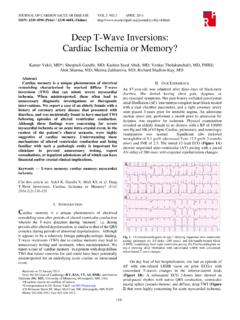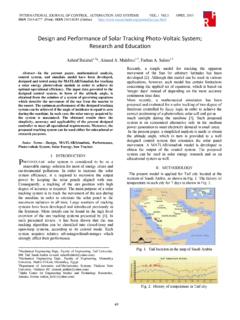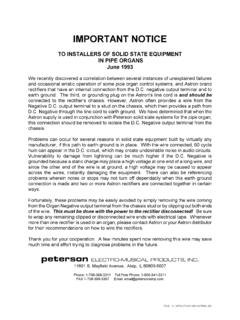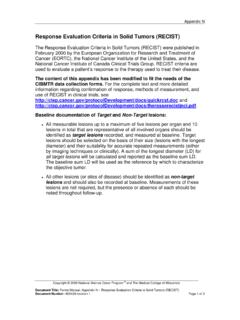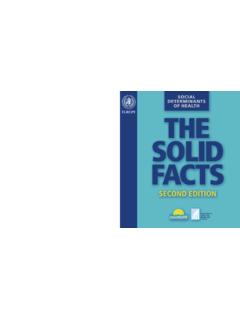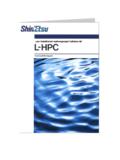Transcription of Donor-Specific Antibody in Solid Organ Transplantation ...
1 INTERNATIONAL TRENDS IN IMMUNITY OCTOBER 2013. ISSN 2326-3121 (Print) ISSN 2326-313X (Online) Donor-Specific Antibody in Solid Organ Transplantation : Where are We? V. Pietroni1, A. Toscano1, F. Citterio1*. 2004 Terasaki and Ozawa suggested monitoring of anti-HLA. Abstract The clinical significance of donor specific HLA antibodies as predictive of Transplantation outcome showing Antibody (DSA), in Solid Organ Transplantation , is still debated. that the presence of post- transplant anti-HLA antibodies were While it is well known that hyperacute Antibody -mediated at higher risk for acute and chronic AMR, compared with those rejection (AMR) may occur in the presence of pre-transplant DSA, without antibodies (p= ) [5].
2 Very recently a new the presence of post-transplant de-novo DSA not always causes definition of acute rejection has introduced the concept that AMR. We discuss the role of DSA in Solid Organ Transplantation , appearance of DSA is critical together with the presence of c4d the methodology to detect DSA and the effect of positive peritubular cells and creatinine increase, to make the immunosuppressive therapy on DSA production. diagnosis of acute Antibody mediated rejection (AAMR). Keywords anti- HLA, DSA, AMR, Luminex, Solid Phase Assay Methodology to detect DSA. Pre-transplant presence of anti-donor HLA antibodies in I.
3 INTRODUCTION the recipient, has always conditioned allograft allocation. CDC. has always been the golden standard to detect the presence of anti-donor antibodies. The limit of CDC is the presence of non Definition of donor specific Antibody (DSA) HLA molecules on the cell membrane that could be an HE association between hyperacute rejection after T Transplantation and the presence of preformed cytotoxic antibodies to donor HLA antigens, has been well known for unspecific target for the anti-HLA antibodies. Moreover, the CDC assay is based on complement fixation, and the existence of specific IgG antibodies not fixing complement, can lead to a more than 30 years [1].
4 DSA antibodies are anti-HLA false negative result. The introduction of Solid phase assay antibodies, specifically generated against donor cells and, for using isolated HLA molecules, allowed to avoid unspecific this reason a positivity at the standard complement-dependent reaction, but rose several questions on the specificity and cytotoxicity test (CDC) before Transplantation has been always sensitivity of these assays. The first Solid phase assay considered a contraindication for Transplantation . Recently, the introduced was the enzyme linked immunoassay (ELISA) in clinical role of DSA has been questioned and it is now debated 1993 by Kao et al.
5 , which was able to detect complement and their role in kidney transplant outcome. non-complement fixing antibodies [6]. The implementation of this assay allowed to finally determine the importance of DSA. History of DSA on graft survival [7]. In 1998, Pei et al., developed an anti-HLA. From the early era the main question in Organ antibodies screening method with microbeads coated with Transplantation has been whether grafts were rejected by purified HLA antigens, detected by flow cytometry [8]. antibodies or by cells. For many years the cellular theory has Recently, Luminex assay, based on HLA molecules attached to been accepted as correct.
6 Gorer, in 1938, was the first to beads, has become the most applied detection methodology. introduce the role of antibodies in tumor Transplantation , Lachmann et al. confirmed the detrimental effect of DSA. demonstrating that hemagglutinating antibodies appeared production on the graft outcome with this metodology [9]. A. concomitantly with the rejection of tumor homografts in mice total of 1014 deceased kidney transplant recipient were [2,3]. Thus, based on these emergent studies on antibodies, monitored for development of HLAab using Luminex Single several groups investigated their role in Transplantation Antigen beads.
7 The presence of DSA in the thirty percent of discovering anti-HLA antibodies. Terasaki, in 2003, showed recipient was associated with a significantly lower graft adequate proofs supporting the humoral theory of survival of 49% vs. 83% in the HLAab negative group (p< or =. Transplantation , describing the association with anti-HLA ). Due to the larger availability of single HLA antigens, antibodies detection, acute rejection or chronic rejection [4]. In this technique is more sensitive and specific , compared to the previous. However, for the same reason this high sensitivity can cause several false positive, affecting the clinical relevance of 1 Department of Surgery, Renal Transplantation Unit, Catholic DSA.
8 Luminex beads in fact, not only accommodate intact University, Rome, Italy. HLA molecules, but also denatured molecules, unmasking *Corresponding Author: Prof. Franco Citterio. Department of hidden epitopes. This denatured molecules are able to react also Surgery, Renal Transplantation Unit, Catholic University, 00168, with natural HLA antibodies, present in non-immunized Rome, Italy. e-mail: 5. INTERNATIONAL TRENDS IN IMMUNITY OCTOBER 2013. ISSN 2326-3121 (Print) ISSN 2326-313X (Online) males [10]. On the contrary, false negative results are affected Methodology and results of pre-transplant clearance by the presence of IgM HLA specific antibodies, able to inhibit Different approaches have been proposed to treat patients IgG binding to the molecules, masking clinical relevant with circulating DSA: 1) remove circulating DSA by allosensitization [11].
9 Moreover, false negative results, are plasmapheresis and immunoadsorption; 2) to block their effect detected with prozone phenomenon, caused by complement with proteasome inhibitors; 3) to reduce the production with component 1 (C1) that competitively can displace the detection anti-CD20. Several studies showed patients undergone antibodies [12]. The extreme sensitivity of Luminex assay can desensitization protocols having a significant survival benefit make difficult the assignment of the positive and negative result. compared to patients who stayed in dialysis or were on the list So far, there is no an accepted standardization for cut-off values for Transplantation .
10 Bonomini et al., in 1985, showed the with MFI (mean fluorescence intensity). The mean benefits of plasma exchange in pre-sensitized kidney transplant fluorescence intensity could vary between centers, depending recipient (30% graft loss) vs pre-sensitized kidney transplant on different company's reagents and operator's ability. This is recipient receiving only standard immunosuppression (81%. the main reason why CDC assays are still leading in Organ 's graft loss) [23]. Montgomery et al. found better patient survival allocation. in transplant patients, after desensitization with plasmapheresis and IVIg treatment, vs the dialysis only group or Clinical evidence of the detrimental role in renal transplant dialysis- Transplantation group [24].


